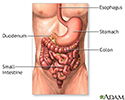Stools - pale or clay-colored
Stools that are pale, clay, or putty-colored may be due to problems in the biliary system. The biliary system is the drainage system of the gallbladder, liver, and pancreas.
Considerations
The liver releases bile salts into the stool, giving it a normal brown color. You may have clay-colored stools if you have a liver infection that reduces bile production, or if the flow of bile out of the liver is blocked.
Bile
Bile is a fluid that is made and released by the liver and stored in the gallbladder. Bile helps with digestion. It breaks down fats into fatty acid...

Yellow skin (jaundice) often occurs with clay-colored stools. This may be due to the buildup of bile chemicals in the body.
Jaundice
Jaundice is a yellow color of the skin, mucus membranes, or eyes. The yellow coloring comes from bilirubin, a byproduct of old red blood cells. Jau...

Dark urine also may occur with clay-colored stools.
Causes
Possible causes for clay-colored stools include:
- Alcoholic hepatitis
Alcoholic hepatitis
Alcoholic liver disease is damage to the liver and its function due to alcohol abuse.
 ImageRead Article Now Book Mark Article
ImageRead Article Now Book Mark Article - Biliary cirrhosis
Biliary cirrhosis
Cirrhosis is scarring of the liver and poor liver function. It is the last stage of chronic liver disease.
 ImageRead Article Now Book Mark Article
ImageRead Article Now Book Mark Article - Cancer or noncancerous (benign) tumors of the liver, biliary system, or pancreas
- Cysts of the bile ducts
- Gallstones
Gallstones
Gallstones are hard deposits that form inside the gallbladder. These may be as small as a grain of sand or as large as a golf ball.
 ImageRead Article Now Book Mark Article
ImageRead Article Now Book Mark Article - Some medicines
- Narrowing of the bile ducts (biliary strictures)
Biliary strictures
A bile duct stricture is an abnormal narrowing, most often of the common bile duct. This is a tube that moves bile from the liver to the small intes...
 ImageRead Article Now Book Mark Article
ImageRead Article Now Book Mark Article - Sclerosing cholangitis
Sclerosing cholangitis
Sclerosing cholangitis refers to swelling (inflammation), scarring, and destruction of the bile ducts inside and outside of the liver.
 ImageRead Article Now Book Mark Article
ImageRead Article Now Book Mark Article - Structural problems in the biliary system that are present from birth (congenital)
- Viral hepatitis
Viral hepatitis
Hepatitis is swelling and inflammation of the liver.
 ImageRead Article Now Book Mark Article
ImageRead Article Now Book Mark Article
There are other less common causes not listed here.
When to Contact a Medical Professional
Contact your health care provider if your stools are not the normal brown color for several days.
What to Expect at Your Office Visit
Your provider will perform a physical exam. They will ask questions about your medical history and symptoms. Questions may include:
- When did the symptom first occur?
- Is every stool discolored?
- What medicines do you take?
- What other symptoms do you have?
Tests that may be done include:
- Blood tests, including tests to check liver function and for viruses that might affect the liver
- Endoscopic retrograde cholangiopancreatography (ERCP)
Endoscopic retrograde cholangiopancreat...
ERCP is short for endoscopic retrograde cholangiopancreatography. It is a procedure that looks at the bile and pancreatic ducts. It is done through...
 ImageRead Article Now Book Mark Article
ImageRead Article Now Book Mark Article - Imaging studies, such as an abdominal ultrasound, CT scan, or MRI of liver and bile ducts
Abdominal ultrasound
Abdominal ultrasound is a type of imaging test. It is used to look at organs in the abdomen, including the liver, gallbladder, pancreas, and kidneys...
 ImageRead Article Now Book Mark Article
ImageRead Article Now Book Mark ArticleCT scan
An abdominal CT scan is an imaging test that uses x-rays to create cross-sectional pictures of the belly area. CT stands for computed tomography....
 ImageRead Article Now Book Mark Article
ImageRead Article Now Book Mark Article
References
Korenblat KM. Approach to the patient with jaundice or abnormal liver tests. In: Goldman L, Cooney KA, eds. Goldman-Cecil Medicine. 27th ed. Philadelphia, PA: Elsevier; 2024:chap 133.
Lidofsky SD. Jaundice. In: Feldman M, Friedman LS, Brandt LJ, eds. Sleisenger and Fordtran's Gastrointestinal and Liver Disease. 11th ed. Philadelphia, PA: Elsevier; 2021:chap 21.
Squires JE, Balistreri WF. Manifestations of liver disease. In: Kliegman RM, St. Geme JW, Blum NJ, et al, eds. Nelson Textbook of Pediatrics. 22nd ed. Philadelphia, PA: Elsevier; 2025:chap 403.
Lower digestive anatomy - illustration
Food passes from the stomach into the small intestine. In the small intestine all nutrient absorption occurs. Whatever has not been absorbed by the small intestine passes into the colon. In the colon most of the water is absorbed from the food residue. The residue is then eliminated from the body as feces.
Lower digestive anatomy
illustration
Lower digestive anatomy - illustration
Food passes from the stomach into the small intestine. In the small intestine all nutrient absorption occurs. Whatever has not been absorbed by the small intestine passes into the colon. In the colon most of the water is absorbed from the food residue. The residue is then eliminated from the body as feces.
Lower digestive anatomy
illustration
Review Date: 8/12/2024
Reviewed By: Jenifer K. Lehrer, MD, Gastroenterologist, Philadelphia, PA. Review provided by VeriMed Healthcare Network. Also reviewed by David C. Dugdale, MD, Medical Director, Brenda Conaway, Editorial Director, and the A.D.A.M. Editorial team.


